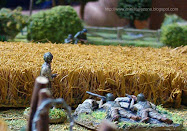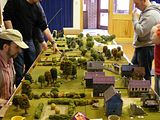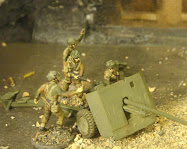An Operational Level Analysis of German Armed Forces Defensive Tactics inHPS Simulations Panzer Campaign Series or"Nicht kleckern, klotzen!" ("Don't tickle, smash!")(1).

Armed forces in modern times exist, fight and die on their military doctrines. Contemporary history from 1900s onwards has no battles where organized armies clashed on battlefields at the whim of individual commanders. A shared way of thinking, military doctrines define and rationalize the existence of an armed force, its operational procedures, techniques and finally the relationship between national strategy and unit-level tactics.
The aim of this article is to create a guideline for HPS Simulations Panzer Campaigns®players in their efforts to guide Wehrmacht to victory on defensive missions.To understand the notion of “defense” as perceived by Wehrmacht, I think it is necessary to elaborate on the operational guidelines that it followed during WW II.
On the strategic and operation level, German Armed forces doctrine was shapes around the idea of Blitzkrieg. I will not dwell on the details of the Blitzkrieg tactics, since they focus primarily on offensive operations. However, certain keystones of the Blitzkrieg have shaped the formation of Wehrmacht units in general.
Schwerpunkt
Blitzkrieg sought decisive actions at all times.
To this end, the theory of a Schwerpunkt (focal point) developed; it was the point of maximum effort. Ground, mechanized and Luftwaffe forces were used only at this point of maximum effort whenever possible. By local success at the Schwerpunkt, a small force achieved a breakthrough and gained advantages by fighting in the enemy's rear. Naturally, the selection of the point of maximum effort depended largely on reconnaissance. In the HPS games this is somewhat easier since at the beginning of each game both sides have perfect information about the enemy’s troop dispositions and unit details.
Paralysis
Having achieved a breakthrough into the enemy's rear areas, German forces attempted to paralyze the enemy's decision making and implementation process. Moving faster than enemy forces, mobile forces exploited weaknesses and acted before opposing forces could formulate a response. Guderian wrote that "Success must be exploited without respite and with every ounce of strength, even by night. The defeated enemy must be given no peace."
Kesselschlacht
An operation's final phase, the Kesselschlacht (cauldron battle), was a concentric attack on an encircled force. It was here that most losses were inflicted upon the enemy, primarily through the capture of prisoners and weapons.Naturally, such concepts shaped the formation, equipment, deployment and finally operations of German land and air units.
UNITS AND THE PHILOSOPHY BEHIND THEIR ORGANIZATION
The building block of German land forces was the infantry arm.Between 1939 and 1943 the German standard infantry division contained three regiments with a total of nine rifle battalions. Each of the infantry regiments had, besides its twelve rifle and heavy weapons companies, a 13th (infantry howitzer) and 14th (antitank) company. The division had also an antitank and a reconnaissance battalion. Organic artillery consisted of one regiment of one medium (150-mm. howitzer) and three light (105-mm. howitzer or gun) battalions with a total armament of forty-eight pieces.
In October 1943 the division was drastically overhauled to reduce its size while maintaining its firepower. Organization charts of the new-style division (with 13,656 men) comprising three regiments of two battalions each had only just been published when further slashes were ordered.
The result was the so-called 1944-type infantry division with an authorized strength of 12,769 men.
The change from 1943 onwards has also affected the combat capabilities of German Infantry Divisions. Reduced personnel strength and the resulting equipment reorganization created formations that retained their original firepower with less men. This of course resulted in the abolishment of the standard practice of keeping divisional reserves behind the Main Battle Zone.Thus, we need to make a distinction between pre-1944 and post-1944 titles in the sense that the defensive strength and manpower of Infantry Divisions will differ significantly and effect game play and tactics.A point however, remains the same.
The Wehrmacht Infantry Divisions are created with the idea that their primary battlefield role would be to combat other infantry formations, liquidation of enemy troops in pocket reductions or frontline holding roles.
Thus, in HPS titles –as it was in real life- an Infantry Division will mostly have only an organic Strumgeschütz Battalion and some FlaK units as mobile elements.
Let us analyze the deployment of a standard 1944 Infantry Division on the field.In HPS games a typical (book strength) German Infantry Division in 1944 is composed of:
3 Infantry Regiments (each regiment consisting of roughly 1000 men)
1 Fusilier or Grenadier Battalion (roughly 400 men)
1 Panzer Jager Abteilung (12 A/T guns)
1 Artillery Regiment (made 48 guns)
1 Pioneer Battalion (roughly 400 men)
1. F.E. Battalion (roughly 350 men)
Total: 4000-5000 men.
Remember that this is a book strength establishment and there were Infantry Divisions defending the front at half their establishment strength or with a compliment of an attached Battalion or Regiment for a total of 6000 men.
This establishment and the composition of a division reflects the philosophy that has remained constant in Wehrmacht thinking from the outset of the war. Even as late as 1944 Infantry units were regarded as responsible for line holding and not mobile operations.
On the other hand, keeping in line with the idea of Blitzkrieg, Wehrmacht created mobile infantry units to keep pace with Panzer Division and conduct offensive encirclement operations.
These units were either Motorized Infantry or Panzergrenadier (Armored Infantry) divisions.
DEFENCE AGAINST MOBILE ENEMY OPERATIONS
Now that the basic philosophy and composition of Wehrmacht Infantry units have been established, we will move on to analyze the possible methods of mobile operations involving division/corps sized units.In my earlier article explaining the employment of Infantry Regiments on the battlefield, I had analyzed various battlefield deployments of Infantry units on the defense. Some points are worth mentioning once again:
1 – Always position and employ your units in as combined a way as possible. Try not to position single companies in the front line if there is a possibility to combine 2-3 companies together. Fatigue incurrence is negatively correlated with unit size.
2 – Try to keep Heavy Weapon companies at least 1 hex behind the front line. Their indirect fire capability and generally high soft attack ratings make Heavy Weapon companies valuable support units.
3 – Prefer woods to plain ground, Cities to woods, Industrial areas to cities. Check elevation and remain on higher ground whenever possible.
When the enemy unit attacks, and if the enemy has mobile elements (tank regiments/battalions) proper utilization of such resources will allow the enemy to penetrate your front line.That should not be a cause for concern at the initial stages. Remember that sustaining the offensive will prove to be much tougher than the defense.
Your opponent will need to consider strengthening and keeping the momentum of his offensive as well as checking for his flank security and maintaining a balance between the penetrating units and his frontline units keeping up the pressure.
The crucial point when your front line is penetrated is to recognize the axis of enemy operations, and the units the enemy is utilizing in his operations.
If you are unable to contain the penetration with units immediately behind the penetration point (at most 10 hexes), than it is time to switch to flexible defense and retreat in an orderly manner.
While retreating, the important points to remember are:
1 – Use of littering: This tactics calls for leaving some small units in the rearguard as the main body of your army retreats under enemy pressure. Always keep units on roads, whether they are primary or secondary. Remember that enemy units will not be able to pass between units maintaining a separation of up to 2 hexes. Try to place AT guns, Inf. Guns or company sized units in the rear in extended line formation. I have just been reminded by Bill Brockman that AT guns no longer project Zones of Control. Thus it is necessary to place another unit in the same hex with the AT gun while littering. While your enemy tries to grind these littering units, move in an orderly manner to the next best defensible terrain.Remember here that unless disrupted your infantry units will move as much as the enemy infantry units. Try not to engage in direct fire battles but retreat and keep the army on the field.
2 – Mobile stopgaps: In corps size unit formations, you will likely have StuG and Pioneer units that have greater mobility than your infantry units. Your StuG units are especially valuable here since they are counted as Hard Units, therefore reducing the damage they will take from enemy infantry units. Try to leave the StuGs rather than anything else in direct contact with the enemy if it is imperative to leave some sort of unit in the direct front line. Unless they are assaulted, your StuGs will live to see the next turn. It is best not to leave anything in direct contact with the enemy if possible. Flak guns, pioneers and Self Propelled artillery units can also be used in such screening roles.
3 – Isolation: A unit that is isolated will likely be destroyed. Try to keep 1 unit that shares a hex boundary with your units that will be isolated in the next turn. This will allow your isolated units to retreat at the cost of full movement points but live 1-2 more turns and block the enemy.
4 – Frontline: Even when your front is penetrated, keep in mind that you have the advantage of intelligence. Your enemy is moving through an area with no knowledge of what lies ahead. You on the other hand, will be able to keep track of the units passing through the gap in your front lines.
Try to hold the flanks of the penetration to a certain extent, and limit the size of the gap in your front lines. Your best efforts should be concentrated not to immediate counterattack but to maintain the flanks and extend defensive positions to the flanks of the penetration.
This should turn your front line into a V shape with the point indicating the area of enemy penetration.
Whenever possible try to contain the enemy penetration and gap blown through your lines to as small a line as possible.
ON TO THE OFFENSIVE
"Nicht kleckern, klotzen!" ("Don't tickle, smash!")
We have discussed about various methods to contain enemy penetrations until now. In this section I will try to outline the basic methods to prepare and launch an offensive against enemy penetrations.For the purposes of our study, I will assume that we have a Korps size unit under our command.
This will normally be possible in medium to long scenarios with enough map space for maneuvering.In Korps size operations, you will normally have 2-3 infantry divisions and 1-2 Panzer Divisions. Infantry divisions will most likely be in the front line with the Panzer Divisions located some 10-30 hexes behind.
You will normally also have Korps level assets under your command; StuGs, 88 mm AT guns, AA guns etc.With the enemy moving through the gap in your front line, the first matter is to establish and recognize an area of counterattack. The area of operations should favorable have as little defensive cover as possible.
Open ground will impair your enemy’s ability to defend against your moves by utilizing natural cover and built up areas, and help your units to utilize their movement factors as much as possible.
Depending on unit dispositions on the map, prefer either of the below methods for counterattack:
1 – Pincer movement: In this method, your mobile divisions should be located on either side of the enemy penetration.
Once the enemy Infantry units start to move through the gap, than you can realize that all mobile elements are already behind your lines.
Strike in concentric waves first to seal the gap, and than with one division turns to engage the penetrating enemy units, while holding the line with the second division.
Utilize Korps level assets to block enemy penetrations further back and form the base where your attacking unit will sweep enemy units.
Try to include the armored-especially Panzer- battalions of the defending Division alongside this attack to possess maneuverability.
HPS Games example:
German summer offensive in Kharkov ’42.2 – Bandwagon:
In such a case where you may find your Panzer divisions placed behind each other, the logical way to utilize them would be to use one to seal off the gap the enemy has torn, and the other to hit the flank of the enemy, causing your opponent to reverse the attack and track back to engage you. It is crucial to refrain from extending your units in line formation along the enemy’s penetration and engage your opponent along a wide frontage.
Remember the philosophy with which your units were created. Schwerpunkt gains its true meaning is such operations as in this case.
Focus on the objective (1 - sealing off the gap, 2 engaging the enemy’s flank) and use your units accordingly. Remember that a 10 hex gap takes 1-2 turns to seal if you can catch the enemy off balance.
After that the enemy units will be “Isolated” and in 1-2 turns low on fuel and ammunition. These will effect its Morale Rating and ability to fight. Restrain yourself and wait for these 1-2 turns to pass. Your opponents units will have to backtrack and try to establish a link with the units bringing up his rear. In such a disorganized manner, they will be easy to isolate and liquidate with your mobile units.
It will take an extremely aggressive and disciplined opponent to continue the advance and try to re-open the gap with the following units.
HPS Games example:
German Counter attack in Korsun ’44 to relieve the encircled forces in the Cherkassy pocket.3 –
Hammer and Anvil: This is the third case where you have one Division on the side of the penetration, and another placed roughly in front of the enemy advance. In such a case, as with the first two scenarios, your primary aim should be to cut off the penetration. Attack with one Division to seal the gap in your lines. Meanwhile, move your second division in front of the enemy movement axis. Once the gap has been closed, attack with the blocking division towards your lines. Your Korps level mobile assets can form loose screens to prevent enemy counter flaking moves. Press forward with the main body of your division, while disengaging mobile units from the first division holding the line. Under normal circumstances this should allow you to possess enough units to encircle the enemy. Keep up the pressure on one side while containing enemy escape from “the bag”.
HPS Games example:
German winter counterattack in Korsun ’42, especially Gold Flashing Sword of Retribution scenario.
PRIMARY POINTS TO CONSIDER
1 – While better equipped and trained than Allied forces, Wehrmacht units are not ultra weapons. Under normal circumstances, a Wehrmacht operational size unit – Regiment or bigger- should be able to withstand attacks from and enemy force twice its strength without significant problems. All of the above analysis and examples have been expressed in the light of at most 1:3 force ratio in favor of your opponent. Any bigger than that, the only possible method of maintaining your forces will be to perform a mobile and ordered retreat, this time utilizing mobile elements and Panzer Divisions and fire brigades to seal off local penetrations. Any ratio greater than 1:2 in mobile elements will make mobile counteroffensive operations very hard to accomplish. Remember that Wehrmacht units normally have higher overall morale ratings and this allows them to incur more fatigue without being disrupted. Try to balance this advantage against enemy’s numerical superiority.
2 – When on the defensive, try to disrupt enemy units with your artillery and Heavy Weapons companies. When you manage to disrupt an enemy unit, move on to the next unit and do not waste any more fire on the disrupted unit. A disrupted infantry unit can move 1 or 2 hexes at most, and this will be less than your undisrupted units. Disruption will allow you to disengage with no losses. Another advantage of enemy disruption is to prevent the enemy from assaulting and flanking your units. Disrupted units can only engage your units in direct fire mode, and their fire values are decreased because of their disrupted state.
3 – Always keep your units within command distance of their respective higher Headquarter units. Never place and waste your HQ units in the front line.
4 – Your air units are most effective in disrupting enemy staging area units. Try to locate enemy units in T mode with your reconnaissance planes and hit them while they are in T mode. If used effectively this will disrupt enemy staging operations and you will lose less airplanes when compared to using them in front line support roles. Expect with good players, you are most likely to locate enemy units in T mode 3-15 hexes behind enemy front lines.
5 – Pictures showing unit deployments discussed in the article will be available shortly.Kind regards


















































No hay comentarios:
Publicar un comentario